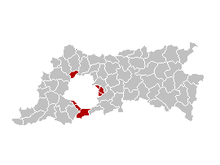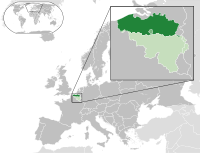Flemish Region
Flemish Region
Vlaams Gewest | |
|---|---|
| Anthem: De Vlaamse Leeuw | |
 | |
| Country | Belgium |
| Seat | Brussels (but not part of the Flemish Region) |
| Government | |
| • Executive | Flemish Government |
| • Governing parties (2014–2019) | N-VA, CD&V, Open Vld |
| • Minister-President | Geert Bourgeois (N-VA) |
| • Legislature | Flemish Parliament |
| • Speaker | Jan Peumans (N-VA) |
| Area | |
| • Total | 13,522 km2 (5,221 sq mi) |
| Population (1 January 2017)[1] | |
| • Total | 6,516,011 |
| • Density | 480/km2 (1,200/sq mi) |
| Demographics | |
| • Languages | Dutch |
| ISO 3166 code | BE-VLG |
| Celebration Day | 11 July |
| Website | www.flanders.be |
The Flemish Region (Dutch: ; French: Région flamande) is one of the three official regions of the Kingdom of Belgium—alongside the Walloon Region and the Brussels-Capital Region. Colloquially, it is usually simply referred to as Flanders. It occupies the northern part of Belgium and covers an area of 13,522 km2 (44.29% of Belgium). It is one of the most densely populated regions of Europe with around 470 inhabitants per square kilometer.
Politics
Immediately after its establishment in 1980, the region transferred all its constitutional competencies to the Flemish Community. Thus, the current Flemish authorities (Flemish Parliament and Flemish Government) represent all the Flemish people, including those living in the Brussels-Capital Region. Hence, the Flemish Region is governed by the Flemish Community institutions. However, members of the Flemish Community parliament elected in the Brussels-Capital Region have no right to vote on Flemish regional affairs.
Administrative divisions

The Flemish Region comprises five provinces, each consisting of administrative arrondissements that, in turn, contain municipalities (in total 308 municipalities in Flanders).
Brussels city, the seat of the Flemish parliament, is located within the Brussels-Capital Region, which is surrounded by the province of Flemish Brabant. Brussels contains both the Flemish Community and the French Community, both having their institutions in Brussels.
| Province | Capital city | Administrative arrondissements | Population (2015) | Area | Population density | |
|---|---|---|---|---|---|---|
| 1 | Antwerp (Antwerpen) | Antwerpen, Mechelen, Turnhout | 1,813,282 | 2,867 km² | 633 / km² | |
| 2 | Hasselt | Hasselt, Maaseik, Tongeren | 860,204 | 2,414 km² | 356 / km² | |
| 3 | Ghent (Gent) | Aalst, Dendermonde, Eeklo, Gent, Oudenaarde, Sint-Niklaas | 1,477,346 | 2,991 km² | 494 / km² | |
| 4 | Leuven | Halle-Vilvoorde, Leuven | 1,114,299 | 2,106 km² | 529 / km² | |
| 5 | Bruges (Brugge) | Brugge, Diksmuide, Ieper, Kortrijk, Oostende, Roeselare, Tielt, Veurne | 1,178,996 | 3,125 km² | 377 / km² | |
Economy
Flanders is home to a diversified modern economy, with emphasis put on research and development. Many enterprises work closely with local knowledge and research centres to develop new products and services.[2]
Transport

"De Lijn" serves as the main public transport company, run by the Flemish government. It consists of buses and trams. TEC is the equivalent company in Wallonia, and MIVB-STIB in Brussels. The railway network run by the NMBS, however, is a federal responsibility.
The Flemish government is also responsible for about 500 kilometers of regional roads (Dutch: gewestwegen) and about 900 kilometers of highways in the territory of the Flemish Region. Other types of roads are provincial roads and municipal roads.
Demographics
Cities
Largest cities in the region include (with population figures in 2015):[3]
- Antwerp (513,570)
- Ghent (253,266)
- Bruges (117,886)
- Leuven (98,376)
- Mechelen (83,975)
- Aalst (83,709)
- Hasselt (76,331)
- Kortrijk (75,219)
- Sint-Niklaas (74,289)
- Ostend (70,460)
- Genk (65,463)
- Roeselare (60,386)
The Flemish Diamond (Dutch: Vlaamse Ruit) is the name of the central, populous area in Flanders and consists of several of these cities, such as Antwerp, Ghent, Leuven and Mechelen. Approximately 5,500,000 people live in the area.
Language
The official language is Dutch, sometimes colloquially referred to as Flemish. The main dialect groups include West Flemish, East Flemish, Brabantian and Limburgish.

French may be used for certain administrative purposes in a limited number of the so-called "municipalities with language facilities" around the Brussels-Capital Region and on the border with Wallonia.
"Rim municipalities" (around Brussels) are Drogenbos, Kraainem, Linkebeek, Sint-Genesius-Rode (French: Rhode-Saint-Genèse), Wemmel and Wezembeek-Oppem. Brussels was originally a Dutch-speaking city, but it was frenchified in the 19th and 20th century and is now largely French-speaking. A few municipalities in the Flemish agglomeration of Brussels are now also frenchified.
Municipalities with language facilities on the border with Wallonia are Bever (French: Biévène), Herstappe, Mesen (French: Messines), Ronse (French: Renaix), Spiere-Helkijn (French: Espierres-Helchin), Voeren (French: Fourons).
See also
- Communities and regions of Belgium
- Provinces of regions in Belgium
- De Vlaamse Leeuw
- Count of Flanders
- Flanders
- Flemish
References
- ^ Population per municipality as of 1 January 2017 (XLS; 397 KB)
- ^ "Flanders | Flanders fits you". Flanders.be.
- ^ "kek_demo". Aps.vlaanderen.be.
External links
- Template:En icon Flemish authorities (Dutch: Vlaamse overheid).
- Template:En icon Flanders online (also in French, German and Dutch).
- Toerisme Vlaanderen
- Template:Fr icon French Flanders
- Template:Nl icon Frans-Vlaanderen
- Template:Nl icon The Flemish region reaches 6 million inhabitants



